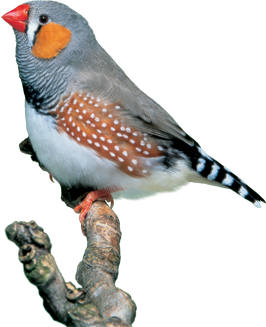Profiles
ZEBRA FINCH
(PoephilaGuttata)
Family: Finch
Origin: Found in more than 90 percent of Australia.
Size: Length is 100mm
Description:
The male bird has a grey head with a grey brown back and wings, a white rump and a black and white striped tail.
It sports a white abdomen with fine black and white barring on the chest and this “two tone” colouring really gives the bird a striking look.
The flanks are chestnut with white spots and the ear coverts are pale chestnut, and its eyes and beak are red and it hops about on orange feet. It’s quite “a snappy dresser”.
The female bird has the same coloured head, back and wings as the male, but its chest is a pale buff and there are no ear patches or flank markings.
The immature chicks are similar looking to the female but have grey brown eyes, black beaks and grey legs.
Care:
Like any bird that you keep as a pet you really need to supply it with the biggest cage that you can afford so that the bird can fly around inside it.
Also the cage needs to be wider than it is tall because birds fly from side to side and not straight up and down. The cage should also be large enough so that one pair of birds can comfortably breed in it.
And if you do use it to breed be sure to add a couple of small nesting baskets and some nesting grass and this will make your pair of finches feel right at home.
If you are able, building an aviary is the best way to house birds as this really lets them have the chance to fly and experience their natural environment.
The aviary should also have some tough non-poisonous plants growing and plenty of perches for the birds to rest on. The birds also love direct sunlight, but they also need to be able seek shade within the aviary when they need it.
Fresh drinking water needs to be supplied each day.
Eats:
Good quality finch or budgerigar mix, millet sprays, fruit, niger, rape, cuttlefish bone, grit, calcium and iodine blocks, chickweed, and silver beet is enjoyed by these birds.
Features: These birds are both tough and curious and if anything new is placed in their cage, or aviary, they will soon be all over it like a “rash”. And if there are several birds living together they will soon stake out their territory around the nesting boxes.
They love people, and they love taking baths so be sure to provide them with a wide shallow dish that they can splash around in. Several mutations of this bird have also occurred.
Call:
It calls out with a harsh nasal “tish”, followed by a soft repetitive “tet”. Once it is in full voice its characteristic call very much resembles a toy trumpet.
Personality:
The bond between finches is thought to last for life, and both sexes will incubate and feed the young. The eggs usually hatch after 12 days and the chicks then leave the nest after just three weeks of being nurtured by their parents.
